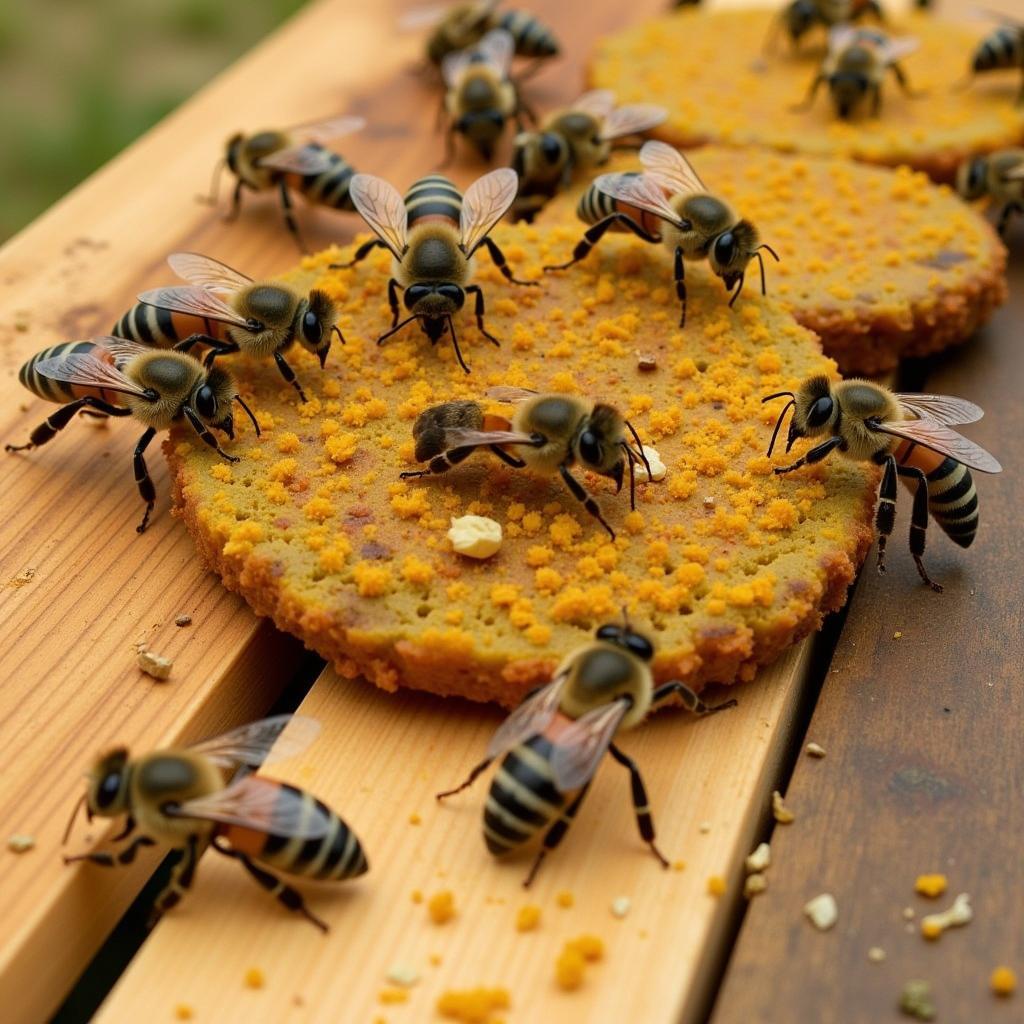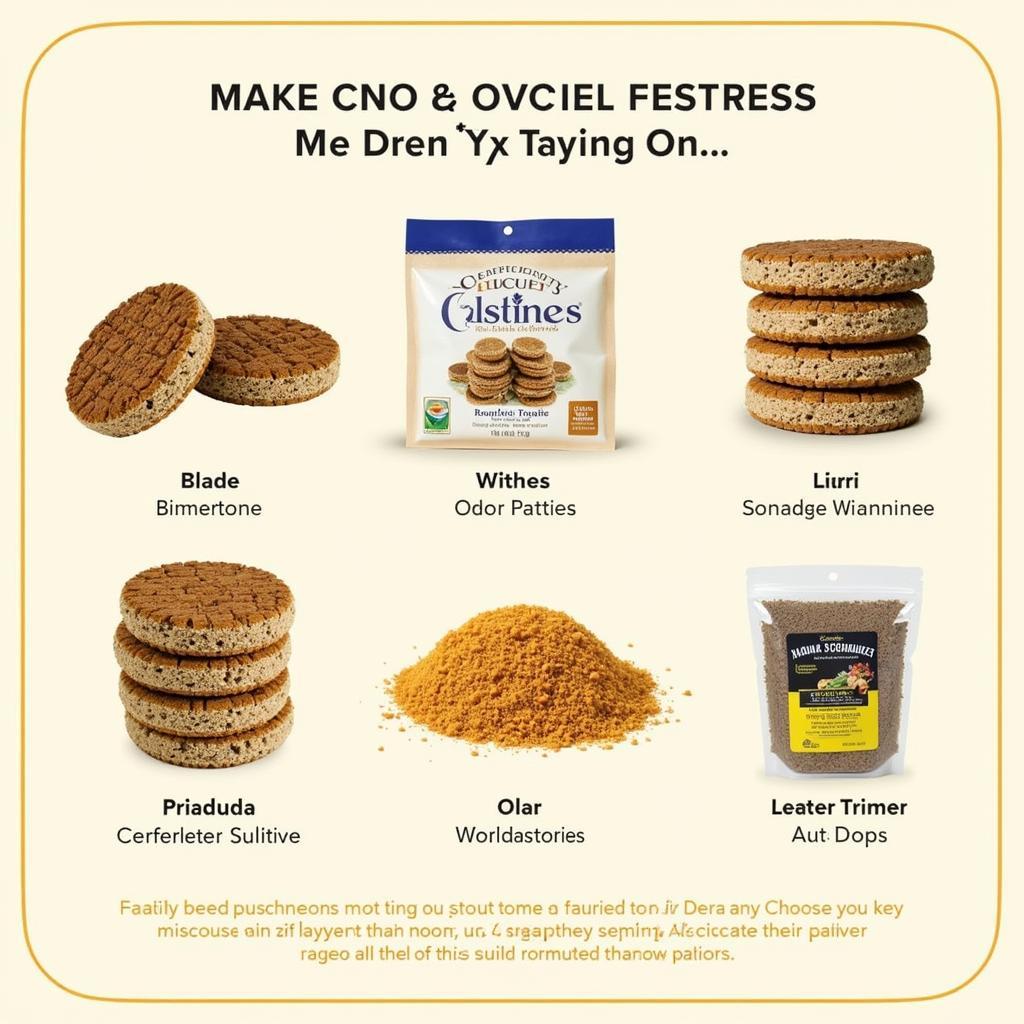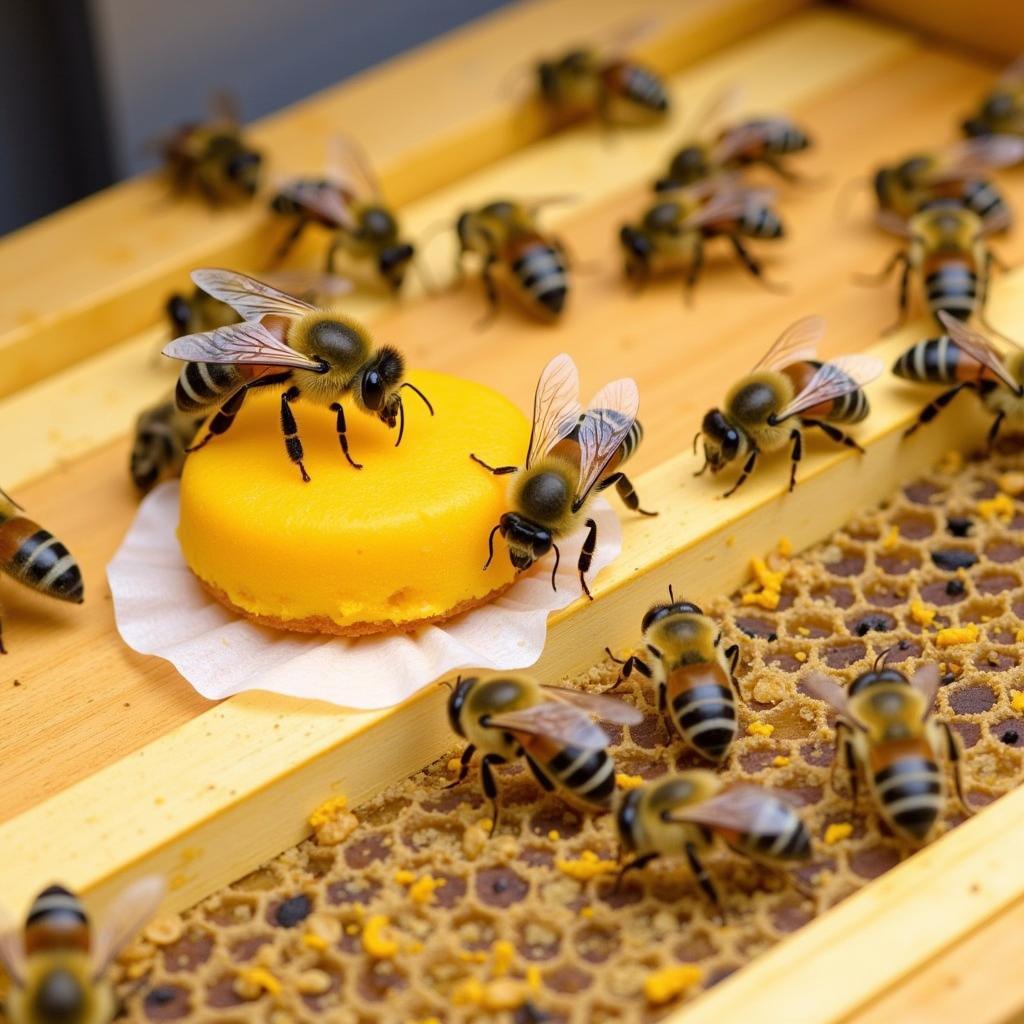Bee Food Patties, a crucial supplement for honeybee colonies, are essential for maintaining hive health and productivity. They provide vital nutrients, particularly during periods when natural pollen sources are scarce. Understanding the importance of bee food patties and how to use them effectively is crucial for beekeepers of all levels. Let’s explore the world of bee food patties and discover how they contribute to thriving bee populations.
The Importance of Bee Food Patties: Why Your Bees Need Them
Bee food patties serve as a nutritional safety net, ensuring your bees have access to essential proteins, carbohydrates, vitamins, and minerals. This is particularly important during the early spring build-up, when colonies are expanding rapidly, and in late winter or early fall when natural forage is limited. Providing supplemental feeding can help prevent colony collapse, strengthen bee immunity, and boost brood rearing.
 Close-up of a bee food patty being consumed by bees
Close-up of a bee food patty being consumed by bees
Proper nutrition is the cornerstone of a healthy bee colony. Just like humans, bees require a balanced diet to thrive. Pollen is their primary source of protein, which is essential for brood rearing, larval development, and overall colony strength. When natural pollen is unavailable or insufficient, bee food patties fill the nutritional gap.
What is a slider food? Perhaps not as crucial to bees, but certainly to us!
Choosing the Right Bee Food Patties: A Guide for Beekeepers
Selecting the appropriate bee food patty for your colony depends on several factors, including the time of year, colony strength, and specific nutritional needs. There are various types of bee food patties available, each with its own unique formulation. Some patties are designed for spring build-up, while others are formulated for winter feeding.
Some common ingredients in bee food patties include soy flour, brewer’s yeast, pollen substitute, and sugar. The ratio of these ingredients can impact the patty’s nutritional value and palatability.
- Protein Content: Look for patties with a high protein content, especially during brood rearing season.
- Sugar Content: Sugar provides energy for the bees. The type and amount of sugar can influence the patty’s attractiveness and effectiveness.
- Additives: Some patties contain added vitamins, minerals, or probiotics to further enhance bee health.
 Various types of bee food patties available for beekeepers
Various types of bee food patties available for beekeepers
Consider the specific needs of your colony when selecting a bee food patty. If your bees are experiencing a pollen dearth, a high-protein patty is essential. If you are preparing your colonies for winter, a patty with a higher sugar content can provide much-needed energy reserves.
How to Use Bee Food Patties: Tips for Optimal Results
Proper placement and application of bee food patties are crucial for maximizing their benefits. Here are some tips for effective usage:
- Placement: Place the patty directly on top of the frames, near the brood nest. This ensures easy access for the bees.
- Quantity: Provide the amount of patty that your bees will consume within a reasonable timeframe, typically a week or two. Avoid overfeeding, as this can lead to spoilage and attract pests.
- Monitoring: Regularly check the patty consumption and replenish as needed. This allows you to assess the colony’s nutritional needs and adjust your feeding strategy accordingly.
- Timing: The optimal time to feed bee food patties is during periods of pollen scarcity, such as early spring, late winter, or during a dearth.
 Bees actively consuming a bee food patty inside the hive
Bees actively consuming a bee food patty inside the hive
Expert Insights on Bee Food Patties
Dr. Emily Carter, a renowned apiculturist, emphasizes the importance of supplemental feeding: “Bee food patties are a valuable tool for beekeepers, especially in challenging environmental conditions. They provide a critical nutritional boost, helping colonies thrive and overcome periods of pollen scarcity.” She further suggests, “Choosing high-quality patties with a balanced nutritional profile is essential for maximizing bee health and productivity.”
Another expert, Mr. David Miller, a seasoned beekeeper with decades of experience, adds, “Proper placement and monitoring are key to successful patty feeding. Observe your bees’ consumption patterns and adjust the feeding schedule accordingly. Overfeeding can be detrimental, so it’s important to strike a balance.”
Conclusion: Nourishing Your Bees with Bee Food Patties
Bee food patties are an invaluable resource for beekeepers, providing crucial nutritional support to honeybee colonies. By understanding the importance of bee nutrition, choosing the right patties, and utilizing them effectively, you can contribute to the health, productivity, and resilience of your bees. Remember, a well-nourished colony is a thriving colony, and bee food patties play a significant role in achieving that goal. For more carnivore friendly fast food options, or to learn about mediterranean food springfield ma you can browse more of our site.
FAQ
-
When should I feed bee food patties? Primarily during periods of pollen dearth, like early spring, late winter, or during a summer nectar flow.
-
How much bee food patty should I give my bees? Provide the amount they will consume within one to two weeks.
-
Where should I place the patty in the hive? Directly on the frames, near the brood nest.
-
What are the main ingredients in bee food patties? Commonly, soy flour, brewer’s yeast, pollen substitute, and sugar.
-
Can I make my own bee food patties? Yes, although ensuring a balanced nutritional profile can be challenging.
-
Are bee food patties necessary for all colonies? While not always essential, they are highly beneficial during periods of pollen scarcity.
-
How can I tell if my bees are benefitting from the patties? Observe increased brood rearing, stronger bees, and greater honey production.
Common Scenarios and Questions:
- Scenario: My bees aren’t eating the patty. Possible Solutions: Try a different brand, check the patty’s placement, or ensure it hasn’t spoiled.
- Scenario: The patty is getting moldy. Possible Solutions: Reduce the patty size to avoid leftovers, ensure proper ventilation in the hive.
- Scenario: My bees seem weak despite feeding. Possible Solutions: Consult a local beekeeping expert or veterinarian to rule out diseases or other issues.
Explore More on Mina Cones Food
For more insights into beekeeping and other culinary adventures, check out our articles on caribbean food delights jamaican beef patties and raw cat food toppers.
Need Assistance?
For further assistance with bee food patties or any other culinary inquiries, contact us at Phone: 02437655121, Email: [email protected] or visit us at 3PGH+8R9, ĐT70A, thôn Trung, Bắc Từ Liêm, Hà Nội, Việt Nam. Our customer care team is available 24/7.